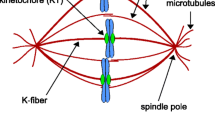Summary
Cells ofEpipyxis pulchra possess two heteromorphic flagella that differ markedly in function, particularly during motility and prey capture. Flagellar heterogeneity is achieved during the course of at least three cell cycles. Prior to cell division, cells produce two new long, hairy flagella while the parental long flagellum is transformed into a new short, smooth flagellum. The parental short flagellum remains a short flagellum for this and subsequent cell division cycles. Although flagellar transformation requires only two cell cycles, developmental differences exist between daughter cells and the maturation of a flagellum/basal body requires at least three cycles.
Similar content being viewed by others
References
Beech PL, Wetherbee R, Pickett-Heaps JD (1988) Transformation of the flagella and associated flagellar components during cell division in the coccolithophoridPleurochrysis carterae. Protoplasma 145: 37–46
Kamiya R, Witman GB (1984) Submicromolar levels of calcium control the balance of beating between the two flagella in demembranated models ofChlamydomonas. J Cell Biol 89: 97–107
Melkonian M, Robenek H (1984) The eyespot apparatus of flagellated green algae: a critical review. Prog Phycol Res 3: 193–268
—,Reize IB, Preisig HR (1987) Maturation of a flagellum/basal body requires more than one cell cycle in algal flagellates: studies onNephroselmis olivacea (Prasinophyceae). In:Wiessner W, Robinson DG, Starr RC (eds) Algal development, molecular and cellular aspects. Springer, Berlin Heidelberg New York Tokyo, pp 102–113
Mignot JP, Brugerolle G, Bricheux G (1987) Intercalary strip development and dividing cell morphogenesis in the euglenidCyclidiopsis acus. Protoplasma 139: 51–65
Reider CL, Borisy GG (1982) The centrosome cycle in PtK 2 cells: asymmetric distribution and structural changes in the pericentriolar material. Biol Cell 44: 117–132
Wetherbee R (1975) The fine structure ofCeratium tripos, a marine armored dinoflagellate. II. Cytokinesis and development of the characteristic cell shape. J Ultrastruct Res 50: 65–76
Author information
Authors and Affiliations
Rights and permissions
About this article
Cite this article
Wetherbee, R., Platt, S.J., Beech, P.L. et al. Flagellar transformation in the heterokontEpipyxis pulchra (Chrysophyceae): Direct observations using image enhanced light microscopy. Protoplasma 145, 47–54 (1988). https://doi.org/10.1007/BF01323255
Received:
Accepted:
Issue Date:
DOI: https://doi.org/10.1007/BF01323255




